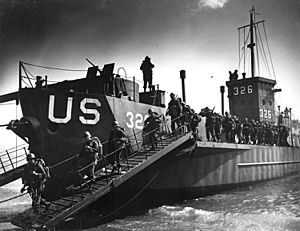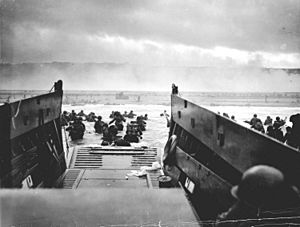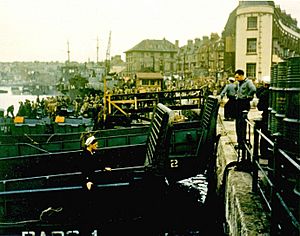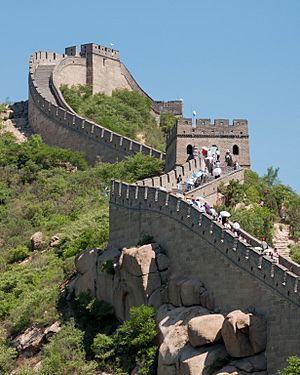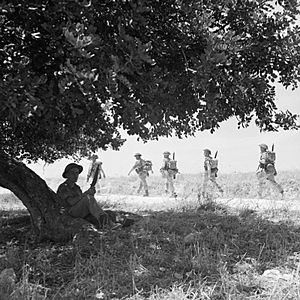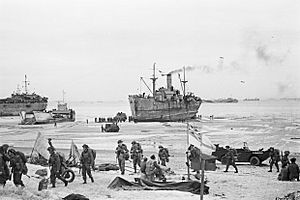Invasion facts for kids
An invasion happens when the armed forces of one country or group enter the land controlled by another. This often leads to the invading group taking over the area, sometimes for a short time, and sometimes for a very long time. History shows that invasions have happened often, even before written records. Usually, the invaded country's army tries to stop the invasion. If there's no strong army, local people might form a resistance movement to fight back.
Contents
Why Invasions Happen
Invasions are often launched to gain new land or to get more power in the world. Sometimes, invaders also want to take valuable things from the invaded area.
Other reasons for invasions can include:
- Getting back land that was lost in the past.
- Religious beliefs.
- Doing what's best for their own country.
- Chasing enemies.
- Protecting friends or allies.
- Taking control of other lands to build an empire (called colonialism).
- Attacking first to stop an enemy from attacking them.
- Protecting or taking control of important routes for travel, water, or oil supplies.
More recently, since the 1800s, powerful countries have sometimes invaded to change or bring back a leader or government in another nation. They might say they are "protecting" the invaded land. These kinds of invasions were often part of imperialism, where powerful countries built empires by taking over weaker ones. What one side sees as taking over, the other might see as freeing people.
Today, countries might use a softer word like "intervention" instead of "invasion" to avoid being called imperialist.
How Countries Defend Against Invasion
Countries that have unfriendly neighbors often set up defenses to slow down or stop an invasion. Besides using natural barriers like rivers, swamps, or rough mountains, countries have historically built strong defenses called fortifications.
These defenses can be:
- Long Barriers: Like the Hadrian's Wall in Britain or the Great Wall of China. These are long walls, trenches, or minefields meant to stop invaders from entering. But these can need a very large army to guard them, which can be expensive.
- Forts and Castles: These are strong buildings like castles placed near a border. They are designed to hold up an invasion long enough for the defending country to gather a large army. These forts can also cut off the invaders' supplies. The idea is that invaders can't just go around these forts; they have to attack them first.
Island countries, like Great Britain or Japan, use their navies to stop invasions. They need a much stronger navy than their enemies and a plan to attack them at sea.
Ways Invasions Happen
There are several ways an invasion can happen, often using a mix of these methods:
- Invasion by Land: This is when armed forces simply march into an area, usually crossing borders or special areas where no military is allowed (like a demilitarized zone). They try to overwhelm any defenses. This can lead to a quick win, but the amount of land gained might be small. It's also hard to keep these plans secret, as most areas have defenses where land invasions are likely.
- Invasion by Sea (Naval Invasion): This uses a large body of water, like an ocean, to bring armed forces into an area, often a coast or an island. This method is often used with other types of invasion. Before airplanes, it was sometimes the only way to reach certain places. A surprise attack from the sea can be a big advantage, especially if the enemy's navy is weak. However, it needs a lot of special equipment, like amphibious vehicles that can go on land and water. It's also hard to set up defenses once you land, and many soldiers can be hurt or killed.
- Invasion by Air (Aerial Invasion): This is a newer method, developed in the 20th century. It involves sending military units by aircraft into an area. The aircraft might land, or troops might jump out using parachutes. This method is good for reaching specific areas that are hard to get to by land or sea. It also offers a better chance of surprising the enemy and getting past their defenses. Often, fewer soldiers are needed. But there can be problems with getting supplies to the troops after they land, and it needs a lot of secret information (spying) to be successful.
Some Major Invasions in History
- Assyrian invasion of the Kingdom of Israel (722 BCE)
- Persian invasion of Greece (480 BCE)
- Macedonian conquest of the Persian Empire (336 BCE - 323 BCE)
- Hannibal’s invasion of Rome (218 BCE)
- The Crusades (1095-1291 CE)
- Genghis Khan’s invasions of China (1206-1227)
- Ottoman Empire’s conquest of Constantinople (1453)
- Conquest of the Aztec Empire by Hernán Cortés (1521)
- French invasion of Russia (1812)
- Nazi invasion of France (1940)
- Nazi invasion of the USSR (1941)
- Allied invasion of France (1944)
- Chinese invasion of Tibet (1949)
Images for kids
-
A defensive wall, the Great Wall of China.
-
View from Dover Castle.
-
The view from a battery at Ouvrage Schoenenbourg in Alsace; notice the retractable turret in the left foreground.
-
German troops march through Warsaw, Poland in 1939 during the German invasion of Poland
-
An LCAC carrying LAVs ashore during the 2003 invasion of Iraq
-
Thousands of paratroopers descend during Operation Market Garden in September 1944.
See also
 In Spanish: Invasión para niños
In Spanish: Invasión para niños


